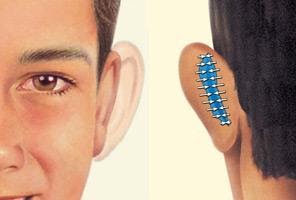Ear Surgery (Otoplasty)
 Ear surgery, also known as otoplasty, can improve the shape, position or proportion of the ear. Ear surgery creates a natural shape, while bringing balance and proportion to the ears and face. Correction of even minor deformities can have profound benefits to appearance and self-esteem. Children, teenagers and adults with the following may benefit from Otoplasty:
Ear surgery, also known as otoplasty, can improve the shape, position or proportion of the ear. Ear surgery creates a natural shape, while bringing balance and proportion to the ears and face. Correction of even minor deformities can have profound benefits to appearance and self-esteem. Children, teenagers and adults with the following may benefit from Otoplasty:
- Overly large ears
- Protruding ears occurring on one or both sides in varying degrees
- Dissatisfaction with previous ear surgery or trauma
- Correction of earlobe defects from previous piercing, gauges or surgery
Your Consultation
In the initial consultation, plastic surgeon Thomas Crabtree, MD will use the time to get to know you, learn about your expectations and discuss a plan to achieve your goals. During the consultation, your ears will be examined to determine if you would benefit from this procedure. Prior to surgery you will have a good understanding of the procedure, plan, and recovery. If you decide you are ready to proceed you will set a date for surgery and be given instructions on how to prepare. You will also schedule a pre-operative appointment to review your medical history, take pre-operative photographs, and confirm the details of your surgery.
Your Procedure
 Correction of protruding ears uses surgical techniques to create or increase the antihelical fold (just inside the rim of the ear) and to reduce enlarged conchal cartilage (the largest and deepest concavity of the external ear). Incisions for otoplasty are generally made on the back surface of the ear. When incisions are necessary on the front of the ear, they are made within its folds to hide them. Internal, nonremovable sutures are used to create and secure the newly shaped cartilage in place.
Correction of protruding ears uses surgical techniques to create or increase the antihelical fold (just inside the rim of the ear) and to reduce enlarged conchal cartilage (the largest and deepest concavity of the external ear). Incisions for otoplasty are generally made on the back surface of the ear. When incisions are necessary on the front of the ear, they are made within its folds to hide them. Internal, nonremovable sutures are used to create and secure the newly shaped cartilage in place.
External stitches close the incision. Techniques are individualized, taking care not to distort other structures and to avoid an unnatural “pinned back” appearance.
For defects limited to the earlobe, the procedure takes just under an hour and is performed under local anesthesia in the office. The goal is to close any holes or tears and recreate a normal appearing earlobe. In the case of “pixie ears” from a previous facelift the goal is to reposition the entire earlobe so it looks natural and not pulled.
Ear Surgery
- Clinic Procedure or Operating Room: Operating room or clinic
- Hospital Status: Outpatient
- Length of Surgery: 1-2 hours
- Anesthesia: Local or General Anesthesia performed under the care of a board certified Anesthesiologist
- Post-Operative: Bandages cover the ears during healing to protect and support the ear’s new shape. Stitches will be tucked behind the ears in the natural creases.
- Recovery Time: Return to normal daily routine in one week, two to three weeks avoiding strenuous activity and several months for scars to fade.
- Results: The results will be evident immediately but will continue to improve and “settle” over the course of several weeks.

